Nikon COOLPIX P600 review
-
-
Written by Ken McMahon
Intro
The Nikon COOLPIX P600 is a DSLR-styled super-zoom camera with an impressive 60x optical zoom ranging from an equivalent 24mm to a whopping 1440mm telephoto. Introduced in February 2014, it has a side-hinged fold-out 3 inch LCD screen and an electronic viewfinder with a resolution of 201k dots. Alongside the P600 Nikon also launched the P530, an update of the earlier P520 with the same 42x optical zoom. Both these models share a new 16.1 Megapixel back-illuminated CMOS sensor.
The P600 has in-built Wifi which allows connection to a smartphone for transferring images and remote controlling the camera, though there’s no NFC for a quick tap connection to an Android smartphone and neither does it have a GPS receiver.
The bridge super-zoom market is a crowded place with plenty of choice from all the major manufacturers and purely on the grounds of zoom range, the COOLPIX P600 is a front runner. Size is important, but its not the only thing that matters. I’ve tested the COOLPIX P600 alongside Sony’s new Cyber-shot HX400V which has a slightly shorter 50x optical zoom but a host of other compelling features. Read my full review to discover which of these two models provides the best mix of features in a super-zoom bridge model.
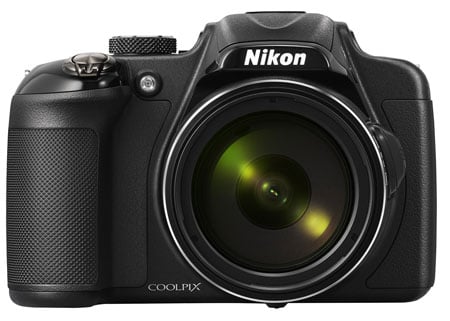 |
Nikon COOLPIX P600 design and controls
Given that it packs a mammoth 60x optical zoom lens, you might expect the COOLPIX P600 to be a little bigger and heavier than earlier COOLPIX super-zooms, but that isn’t the case; Nikon has managed to squeeze the 60x zoom into a body that, in all but one dimension is the same size as the 42x P520, but with a longer lens barrel. The COOLPIX P600 measures 125x85x107mm and weighs 565 grams with battery and card – that’s very compact compared with most other long reach super-zooms and significantly smaller than the chunky Sony HX400V which measures 130x93x103 and weighs 660g.
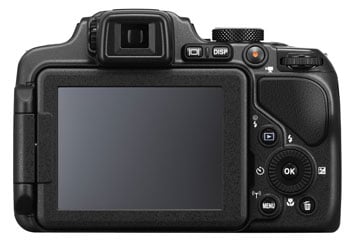 |
The overall styling of the COOLPIX P600 isn’t radically different to the earlier P520, the contours take a slightly different line here and there, so they’re not identical twins, but you need to look closely to tell them apart. The controls too have a lot in common – by which I mean they’re virtually identical. On the top panel everything is on the right side of the pop-up flash. The mode dial has the same PASM positions, three dedicated Scene mode position and SCN for the rest plus Auto. To the right of it on the grip extension you’ll find the on/off button, Function button and shutter release with zoom collar.
On the back the control dial is flanked by playback, menu and delete buttons with a movie record button conveniently positioned just above the thumb rest. Here, just above the screen you’ll also find a button for toggling display overlays and – pretty much the only departure from the the earlier P520 control layout a button for toggling between the screen and the viewfinder.
The screen is a 3 inch LCD panel with resolution of 921k dots. That’s exactly the same resolution as the Sony HX400V’s screen and they both provide a bright detailed image that’s viewable from a wide angle. The difference is the mounting. While the HX400V has an articulated hinge at the bottom allowing you to flip it up and down, the COOLPIX P600’s screen has a hinge at the side with the screen mounted on a rotating pin. This allows you to turn it in any direction – facing forward for selfies, orientated for portrait format shooting, and folded in on itself for protection.
The COOLPIX P600 has an electronic viewfinder with a 201k dot resolution. Like other manufacturers Nikon has stuck with what is by today’s standards a low resolution viewfinder for several generations of its super-zoom range. Canon likewise has an ageing 201k dot EVF in the SX50 HS and Sony has opted for the same low cost option with a 0.2in 201k dot EVF in the HX400V. If you want a more up-to-date better quality viewfinder in a bridge super-zoom consider the Fujifilm FinePix S1 which has a 0.2in 920k dot EVF. Though Panasonic raised the bar for super-zoom viewfinder quality with a 1.3 million dot EVF in its flagship FZ200, that model has a smaller 24x optical zoom range. For the 60x FZ70 / FZ72 we’re back to the 201k dot viewfinder, so it seems that long zooms and high resolution viewfinders aren’t a combination manufacturers are yet ready for.
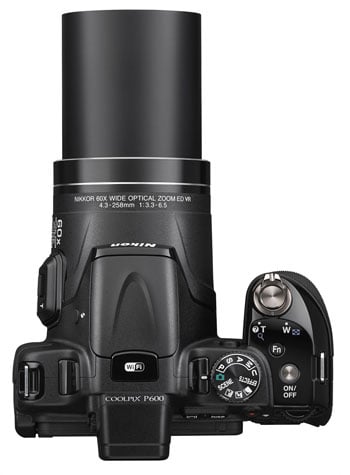 |
Unlike the Sony HX400V, the COOLPIX P600 has no eye sensor to automatically switch from screen to electronic viewfinder, but as I already mentioned, there is a button for manually switching. There’s also an automatic mechanism that switches to the viewfinder when the screen is folded inwards.
On the right side of the COOLPIX P600’s body mini HDMI and a combined USB / AV out port are located behind a soft plastic flap. Nikon provides a USB cable in the box which can be used to charge the camera from a computer as well as for transferring photos and video.
The COOLPIX P600’s combined battery and card compartment is located in the grip and accessed via a door in the base of the camera. It takes a new EN-EL23 battery with a power rating of 1850mAh. That delivers enough power to take 330 shots, broadly comparable with the Sony HX400V’s 300 shots, the PowerShot SX50 HS’s 315 shots or the Panasonic Lumix FZ70 / FZ72’s more generous 400 shot capacity. The P600’s battery is charged in the camera via the USB port using the supplied cable and either the supplied charger, or, as I’ve mentioned, by plugging it into a USB port on your computer.
The COOLPIX P600 has a built-in flash which is raised mechanically by pressing a button on the left side of the body just below the flash head. Once in the raised position you can select the flash mode by pressing the top position on the multi selector four-way control wheel. The options are Auto, Auto with red-eye reduction, Fill flash, Slow sync and Rear-curtain sync. When you’ve finished using the flash you just push it back down into the closed position.
The flash has a maximum distance at the wide angle lens setting, with the aperture set to f3.3, of 7.5 metres, not at all bad though as it’s quoted with the ISO set to auto it’s not easy to make comparisons. If you make the (most likely correct) assumption that the distance is calculated using the default maximum auto ISO sensitivity of 1600 ISO, that means it delivers a little less power than the Sony HX400V. But you can fit an external flash to the HX400V’s hot shoe / accessory port, an option the P600 lacks. The HX400V’s accessory and USB ports also support other accessories that aren’t available for the P600, including an external microphonre which slots on the hotshoe and a cabled release.
Nikon COOLPIX P600 lens and stabilisation
The COOLPIX P600 has a 60x optical zoom with an equivalent range of 24-1440mm. There are very few super-zooms on the market that can equal that, but if zoom range is your number one priority, the Panasonic Lumix FZ70 / FZ72 is one alternative, Samsung’s WB220F is another. Both those models have a 20-1200mm equivalent range with a much wider wide angle than the COOLPIX P600, but a shorter 1200mm telephoto. So the COOLPIX P600 gets the prize for the longest focal length. I should also mention Sony’s H400 which tops them all with a 63x zoom; note this is a different model to the HX400V.
The COOLPIX P600’s lens has a maximum aperture of f3.3 at the wide angle setting, closing to f6.5 at the maximum telephoto. That compares with f2.8 – 6.3 on the Sony HX400V – about half a stop brighter at the wide angle setting, but the difference whittled away the more you zoom in.
Nikon COOLPIX P600 coverage wide | Nikon COOLPIX P600 coverage tele | |
 |  | |
| 4.3-258mm at 4.3mm (24mm equiv) | 4.3-258mm at 258mm (1440mm equiv) |
If a bright aperture throughout the zoom range is important to you, you should look at Panasonic’s Lumix FZ200 which boasts a constant f2.8 aperture throughout its 25-600mm equivalent range. Yes, it may only zoom in half as close as the Sony HX400V, but when both are at 600mm, the Panasonic is two stops faster, so you need to weigh up whether aperture or reach is more important to you.
Stabilisation is a key factor with long zooms and the COOLPIX P600 is equipped with optical image stabilisation or Vibration Reduction as Nikon calls it. There are two options, Normal and Off as well as an Active mode that irons out excessive wobbling, examples of the kinds of conditions it might be useful in, according to the manual, are ‘when shooting from a car or under poor foothold conditions’.
Active mode was introduced on the earlier COOLPIX P520 and when I tested it, in normal handheld operation I found little difference between the Active and Normal settings. For more details see my Nikon COOLPIX P520 review. To test the stabilisation on the COOLPIX P600, set it to Normal mode and zoomed in to its maximum 1440mm equivalent focal length and took a sequence of hand-held shots in Shutter Priority mode at progressively slower shutter speeds. In Normal mode the COOLPIX P600 can shoot hand-held around four stops slower that the photographer’s rule of thumb says is advisable.
In addition to Vibration reduction the COOLPIX P600 also includes the Motion detection feature common on Nikon compacts which raises the shutter speed and/or ISO sensitivity in Auto and some scene modes to avoid shutter speeds that are likely to result in camera shake.
Nikon P600 Active Intelligent SteadyShot | ||||
 | 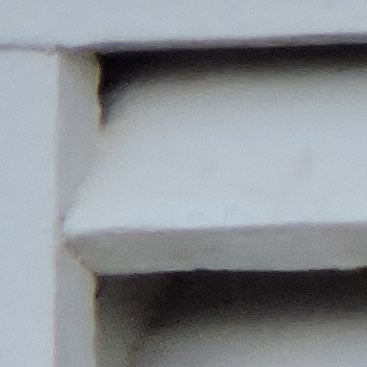 | |||
4.3-258mm at 258mm, 100 ISO, 1/80th, Normal VR. | 100% crop , 4.3-258mm at 258mm, 100 ISO, 1/80th, Normal VR. | |||
Nikon COOLPIX P600 shooting modes
The COOLPIX P600 can be used as a point and shoot in Auto mode. This is an old school auto mode with no scene detection to detect backlit or moving subjects, for that you need Scene Auto selector mode, which uses Scene detection to automatically choose the most appropriate scene mode for the subject from one of ten scene options. The available scene modes are: portrait, group portrait, landscape, night portrait, night group portrait, night landscape, close up, backlighting (non-human), backlighting (human) and other.
Switch to the PASM modes and you have a range of semi auto and fully manual modes to choose from. In PASM modes both the Command dial and multi-selector wheel are used to change the appropriate exposure control; the command dial thumb wheel engages program shift in Program auto and the shutter speed in Shutter priority and Manual modes. The multi selector wheel is allocated to the aperture in Aperture priority and Manual modes. So far, so straightforward, but it’s a bit of a shame the redundant dial is just that – the command dial is disabled in Aperture priority mode, likewise the Multi selector wheel in Shutter priority mode.
The COOLPIX P600 has 20 manually-selected scene modes. Three of them – Landscape, Night landscape and Night Portrait have dedicated positions on the mode dial and the rest are accessed from a menu when the mode dial is in the Scene position. In addition to the usual suspects from Portrait to Party via Landscape, Sports, Beach, Fireworks, Backlighting and Sunset, there are two new additions – Moon and Birdwatching. Moon provides a selection of tint options which you can select on screen. More usefully, a small square in the middle of the frame indicates the area framed when fully zoomed in, so with the camera on a tripod you can frame the moon in the small square then press OK to automatically zoom the lens all the way in. Theoretically, at least, in practice, as anyone who has tried to shoot the moon wil now, framing is a tricky business. That said, the new Moon scene mode may be enough to encourage first timers to have a crack at lunar photography.
Birdwatching mode offers single shot and continuous modes, the later shooting a 7 frame burst in a second. Like Moon mode, it provides a frame guide and zooms in automatically, this time to 800mm. The arbitrary limit on the focal length is a bit of an imposition though and I reckon most bird photographers will be happier just to use program auto mode and set the set the drive mode to one of the continuous options.
 |  |  |
There are two panorama modes for shooting 180 and 360 views. Both work along the same lines as Sweep Panorama on Sony compacts and its numerous clones – you press the shutter once and pan the camera as smoothly a you can. You can pan with the camera in portrait or landscape orientation – the P600 works out which, you don’t need to tell it beforehand. More often than not that’s all you need to do; the camera stops shooting when you complete the sweep and stitches the images into a single 180 or 360 view. Portrait mode produces the largest images which are 1536 x 4800 pixels for 180 panoramas and the 360 ones measure 1536 x 9600.
If your panning technique leaves something to be desired, or there are objects close to the camera, there’s a lack of detail for it to match up, or for some other unknowable reason it occasionally doesn’t make the full sweep, in which case it saves the partial view for you providing you got more than half way round.
Another feature the COOLPIX P600 shares with the Sony HX400V is its composite HDR mode, which on the COOLPIX P600 is called the Backlighting scene mode. This provides the option of one of three HDR modes which shoot a fast burst of bracketed images and produces a composite HDR image from them.
Unlike Auto HDR on the HX400V, which lets you set the ISO sensitivity manually, it’s set automatically in Backlight scene mode on the COOLPIX P600. In addition to the HDR composite the COOLPIX P600 also saves a non-HDR composite shot.
Finally, the effects position on the mode dial provides a range of filters which you can apply in-camera to reproduce traditional darkroom techniques. A selection of these is shown above. As on the Sony HX400V, these filters are applied in camera and there’s no original or RAW file to fall back on should you not like the result.
Nikon COOLPIX P600 movie modes
The COOLPIX P600 offers the choice of two Full HD video modes – 1080p25 and 1080i50. There’s also 720p25, iFrame 720p25 and 480p25. All of the video modes are also available in 30fps format.
That’s just the normal speed modes; the COOLPIX P600 also has several HS options for playback at speeds other than real time. HS480/4x shoots 640×480 video at 4x normal speed (100 or 120fps depending on whether you have PAL or NTSC video mode selected) which plays back at quarter speed. HS720/2x records 1280×720 at double the normal frame rate for half speed playback, and finally 1080/0.5x records full HD video at half the normal frame rate for double-speed playback. As with the normal speed modes, these high speed modes are also available at 30fps.
Audio isn’t recorded with the HS video modes but I was pleasantly surprised to discover that you can use the effects filters. The only limitation on this is that the Soft and Nostalgic sepia effects are only available with the HS720/2x mode. I should also mention that you can’t use the use zoom or Full-time AF with the HS modes. Regardless of that, this is an impressive range of high speed recording modes and surpasses what the completion offers. The Sony HX400V doesn’t provide any high speed modes, and though the PowerShot SX50 HS provides two – at 4x and 8x – they are at VGA (640×480) and QVGA (320×240) resolutions respectively.
The COOLPIX P520 doesn’t have a movie position on the mode dial, so recording is started by pressing the dedicated record button whatever mode you’re in. One of the drawbacks of this approach is that you can’t frame up your shot very easily as the screen switches from 4:3 proportions to 16:9 (assuming your shooting in one of the HD or iFrame modes). But there is a least a display mode that superimposes the 16:9 area on the 4:3 screen for you.
| |
|---|---|
| |
| |
| |
|---|---|
| |
| |
| |
|---|---|
| |
| |
| |
|---|---|
| |
| |
Nikon COOLPIX P600 Wifi
The COOLPIX P600 has built-in Wifi, allowing you to wirelessly connect using a smartphone, remotely control the camera and download images. The Nikon Wireless Mobile Utility app is available free for iOS and Android and I tested the COOLPIX P600’s wireless features using my iPhone 4S.
Unlike the Sony HX400V, the COOLPIX P600 doesn’t have NFC, so even if you have an NFC-equipped android phone you’ll need to connect to the camera by selecting its SSID from your phone’s Wifi settings. You then have to switch to the app or the connection will time out after about a minute.
You can then download photos to your phone, though not at the original size. There are two options, ‘Recommended’ which is optimised for your device screen and VGA. This is a shame as original size downloads are available with Nikon’s Wifi equipped DSLRs. One of the other drawbacks of Nikon’s app is that it doesn’t allow direct uploads to social networking and photo sharing sites, but that just means you have to download to your phone prior to sharing.
Controlling the camera remotely is simple, but again the options are limited. You can zoom the lens, but there isn’t the same degree of control as on the camera, instead the zoom lurches in and out in quite large discrete steps with each tap of the screen icon. It’s not possible to switch exposure modes using the app and there’s no control over exposure of any kind, not even exposure compensation. There is a self timer though.
So the COOLPIX P600’s Wifi features are quite basic, but no less sophisticated than those of the Sony HX400V. In fact the experience of remote shooting and wireless transfer using both models is very similar, though the HX400V has NFC so is a better option if you have an NFC-equipped phone and also allows you to transfer full resolution images. But basic though it is, the COOLPIX P600’s built-in Wifi is a very worthwhile feature to have.
Nikon COOLPIX P600 Handling and Sensor
Like earlier Nikon Super-zooms, the COOLPIX P600 can be frustratingly slow at some things. Once it’s started up, it’s quite nifty, the AF responds quickly in most situations and it has a good selection of continuous shooting modes including a 7fps single second burst at full resolution and a range of lower resolution modes. But the menu system is sluggish – when you press the menu button the screen goes blank and it takes almost a second for the menu to appear. And there’s also a very noticeable delay when switching between tabs.
When the movie record button is pressed there is a full three second gap while the screen goes black – the recording delay itself isn’t quite that long, but it doesn’t help that you can’t see what you’re shooting in the meantime.
The COOLPIX P600’s menu system is divided over four tabs, Shooting, Movie, GPS and Set up. The Shooting menu is a long list of 18 items, so changing something like the AF mode, or Active D-lighting, which are in the middle somewhere, can be a bit tedious. The COOLPIX P600 does have a single programmable function button, though, which can be assigned to one of nine functions including image quality, size, white balance, metering, continuous shooting, ISO sensitivity, AF area mode and Vibration reduction.
The one big improvement to the COOLPIX P600’s handling over earlier models is the introduction of the monitor button which toggles the display between the screen and the EVF. In the absence of an eye sensor this is a real lifesaver, saving you the tedium of having to flip the screen back in on itself in order to activate the viewfinder. If I was a COOLPIX P520 owner this seemingly innocuous improvement would be second (after the big zoom) on my list of reasons for upgrading.
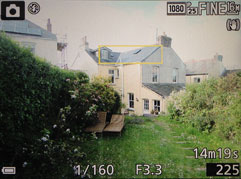 | 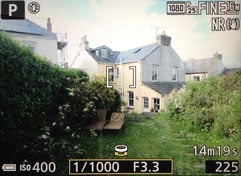 | 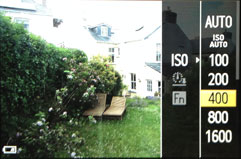 |
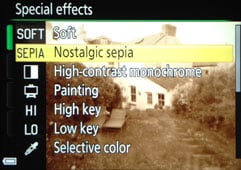 | 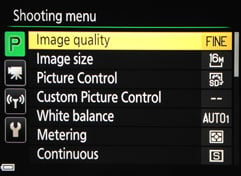 | 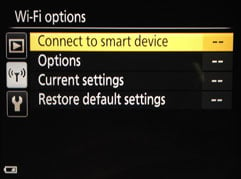 |
The COOLPIX P600 has a 16.1 Megapixel 1/2.3in compact sensor that produces images with a maximum size of 4608 x 3456 pixels. Its ISO sensitivity range is from 100 to 6400 ISO and in Manual mode its shutter speed range is 4s – 1/4000. It saves images as JPEG files at one of two quality/compression settings and at the best quality Fine setting image size is on average around 5 to 7MB.
To see how the quality of the Nikon COOLPIX P600 measures-up in practice, take a look at my Nikon P600 quality and Nikon P600 noise results pages, browse my Nikon P600 sample images, or skip to the chase and head straight for my verdict.
 The Nikon COOLPIX P600 is a DSLR-styled superzoom with a massive 60x optical range, equivalent to 24-1440mm. It also sports a fold-out 3in screen, electronic viewfinder and Wifi which allows connection to a smartphone for transferring images and remote controle. The bridge superzoom market is a crowded place with plenty of choice from all the major manufacturers and purely on the grounds of zoom range, the COOLPIX P600 is a front runner.
The Nikon COOLPIX P600 is a DSLR-styled superzoom with a massive 60x optical range, equivalent to 24-1440mm. It also sports a fold-out 3in screen, electronic viewfinder and Wifi which allows connection to a smartphone for transferring images and remote controle. The bridge superzoom market is a crowded place with plenty of choice from all the major manufacturers and purely on the grounds of zoom range, the COOLPIX P600 is a front runner.



